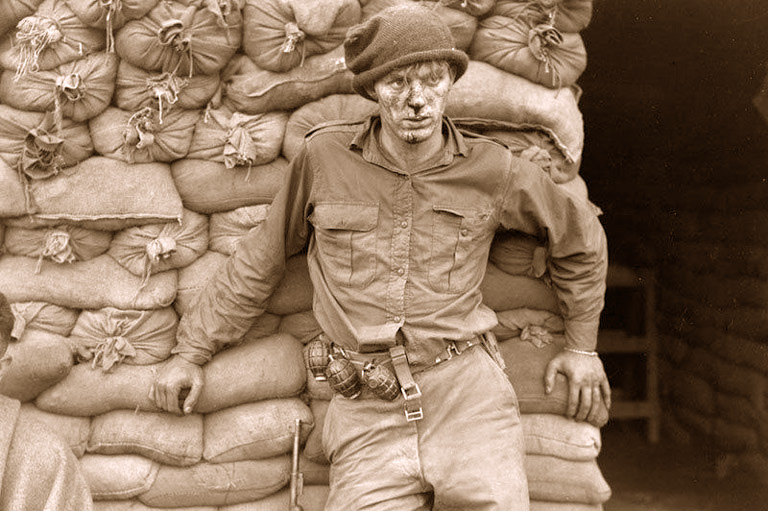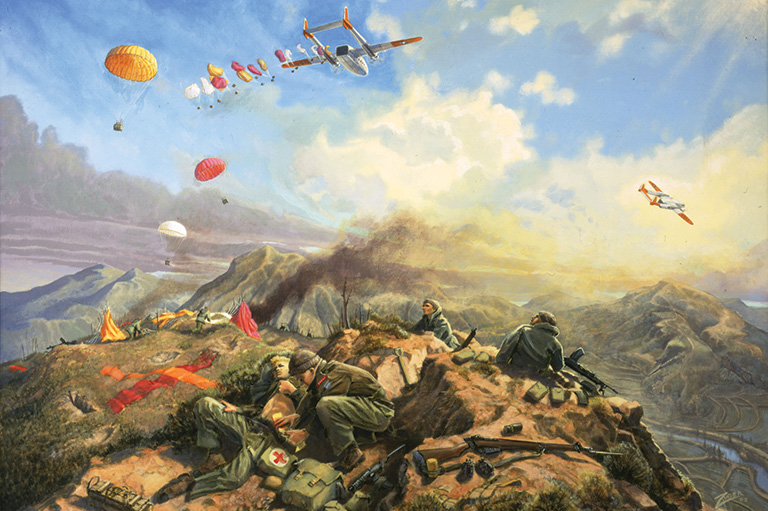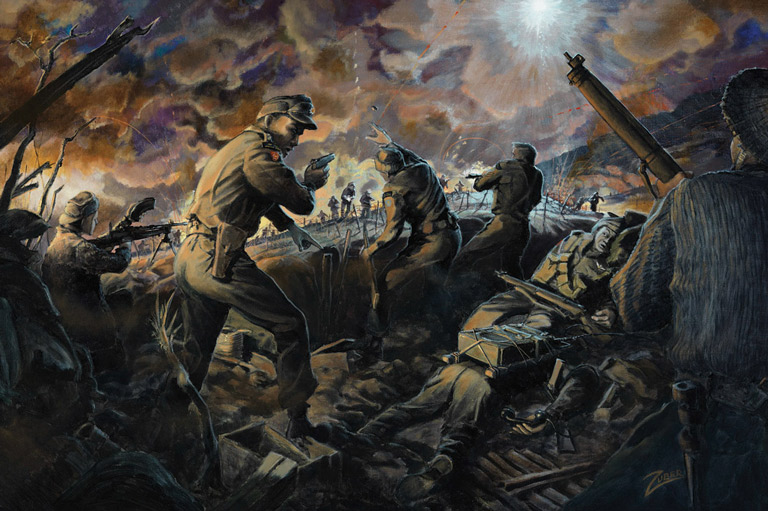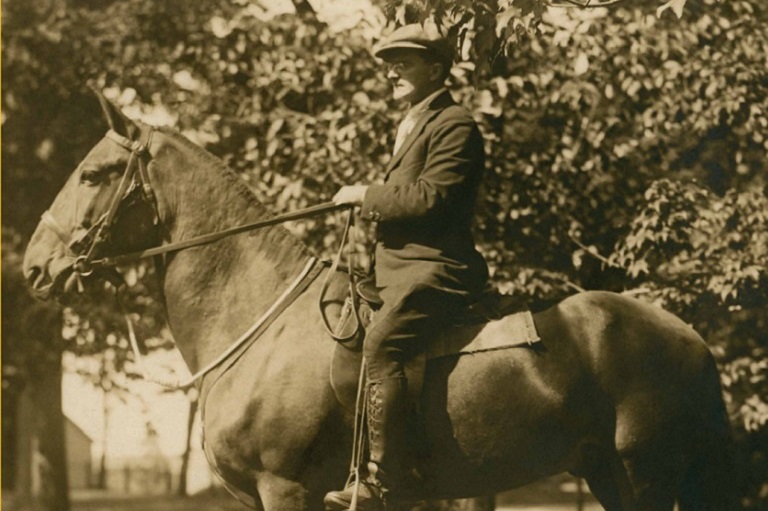No Retreat, No Surrender

In April 1951, thousands of Chinese troops came streaming towards the Kapyong Valley, just sixty kilometres from the South Korean capital of Seoul. The Chinese had launched a new and major offensive in the Korean War, broken through American lines, and forced U.S. and South Korean troops to retreat, withdrawing through the valley.
Standing in the way of the enemy, which was attempting to seize Seoul, were seven hundred Australian troops atop one of the hills overlooking the valley, and another seven hundred members of the 2nd Battalion, Princess Patricia’s Canadian Light Infantry (PPCLI), atop another.
What would become known as the Battle of Kapyong — fought from April 22 to 25, 1951 — was about to unfold.
With 7 uniquely curated newsletters to choose from, we have something for everyone.
The Chinese first attacked the Australians, who were supported by U.S. tanks. Even though they were heavily outnumbered, the Australians clung on until the afternoon of April 24 before retreating. The Canadians, situated on what was known as Hill 677, were ordered to hold their positions. “No retreat, no surrender,” Canadian Army Lieutenant Colonel Jim Stone told his men.
Stone — a Second World War veteran who would eventually retire with the rank of colonel — had already mapped out the battlefield and the approaches to Hill 677 in advance, recalled retired Canadian Army Major Murray Edwards, who took part in the battle. As part of Stone’s plan, a route had been constructed to allow twelve half-track armoured vehicles, equipped with heavy machine guns and mortars, to position themselves in key locations. “Our colonel anticipated everything that was going to happen and put us into the position to deal with it,” said Edwards, now 103.
The former soldier said the fighting on Hill 677 was at times intense. Ammunition ran low. Chinese human-wave attacks were beaten back, sometimes by hand-to-hand combat. At one point, a platoon commanded by Lieutenant Mike Levy was on the verge of being overrun by Chinese troops. As the enemy advanced within seven metres of their location, Levy ordered his men to hunker down, and he then called for artillery fire on his own position.
Allied artillery crews fired hundreds of shells at Hill 677; the Chinese attack was decimated, but, miraculously, none of Levy’s men were killed. “The Chinese were very dependent on throwing large numbers of soldiers into battle,” said Edwards. “But overwhelming force when it meets overwhelming firepower comes to a stop.”
The tenacity and bravery of the Canadians on Hill 677 halted the Chinese and North Korean attacks, allowing United Nations forces to push in reinforcements to stop the enemy’s spring offensive. But the battle of Kapyong came at a price. Ten Canadian soldiers were killed and twenty-three wounded during the fighting. It is estimated that more than one thousand Chinese soldiers were killed. The 2nd Battalion of the PPCLI received a United States Presidential Unit Citation for their actions.
The Battle of Kapyong was but one of a number of significant clashes in what has become known as “the forgotten war.” July 27, 2023, marks the seventieth anniversary of the signing of the armistice that brought an end to the fighting on the Korean Peninsula.
More than 26,700 Canadians served in the United Nations force that came to South Korea’s aid after troops from communist North Korea invaded on June 25, 1950. More than 1,200 Canadians were wounded and 516 lost their lives in the conflict, in which North Korea received military support from China, as well as supplies, strategic advice, and diplomatic backing from the Soviet Union. “Korea was a war no one expected,” explained Andrew Burtch, the Canadian War Museum’s Cold War historian. “But it was also a war that Canada didn’t particularly wish to fight.”
The Korean conflict came at a time when Canada was in the midst of dismantling the extensive military capabilities that it had built up during the Second World War. Soldiers had returned to civilian life; Canada’s wartime force, in which more than one million had served, was reduced to around fifty thousand. In addition, Canada’s interest in 1950 was focused on Europe; the Korean Peninsula was seen as an area in the American sphere of interest, said Burtch.
Advertisement
After the defeat of Japan in the Second World War, the Korean Peninsula — which had been annexed by Japan in 1910 — was divided by the victorious powers into North and South, along the thirty-eighth parallel. The United States held sway over the South, while the Soviet Union exercised its influence over the North. As the two superpowers became Cold War enemies, the escalating tension between liberal-democratic and communist countries culminated in Korea with the North’s invasion of the South. This led the United Nations to pass Security Resolution 83, which authorized the use of military force to restore peace on the Korean Peninsula. (The Soviet Union, a permanent member of the UN Security Council, did not veto the resolution because it was boycotting the UN at the time.)
Prime Minister Louis St. Laurent framed Canada’s commitment to South Korea as support to the United Nations. “Any participation by Canada ... would not be participation in war against any state,” the prime minister said. “It would be our part in collective peace action under the control and authority of the United Nations for the purpose of restoring peace.”
“The war was pitched as a situation where a fledgling democracy needed our help,” Burtch explained.
In total, twenty-one nations volunteered under the UN flag to assist South Korea — sixteen nations provided combat troops, equipment, and armaments, while five nations provided non-combat assistance by sending medical ships with staff and medicine. Despite the initial reluctance of the Canadian government, the country’s military personnel would play a significant role in the war.
Canadian troops found themselves engaged in pitched battles with North Korean and Chinese forces. Seven months after the Battle of Kapyong, Canadians were fighting for Hill 355, some forty kilometres north of Seoul. In that battle, the Canadian Army suffered sixteen dead, forty-four wounded, and three taken prisoner. Almost a year later, Canadian soldiers would again be fighting in the area of Hill 355. The back-and-forth struggle for the hill ended with Canadian soldiers in control of the area but at a cost of eighteen dead, thirty-five wounded, and fourteen men taken prisoner.
In the air, Canadian pilots flew transport missions, carrying thirteen thousand personnel and three million kilograms of freight between North America and Korea. Twenty-two Royal Canadian Air Force pilots assigned to U.S. squadrons participated in combat operations. Of those, Flight Lieutenant Omer Lévesque shot down a MiG-15 Chinese fighter jet on March 30, 1951, becoming the first Canadian pilot to destroy an enemy aircraft in the war. He received the U.S. Distinguished Flying Cross for his actions.
Save as much as 40% off the cover price! 4 issues per year as low as $29.95. Available in print and digital. Tariff-exempt!
Royal Canadian Navy ships conducted patrols off the Korean Peninsula and bombarded targets on the shore. Over the course of the three-year war, Royal Canadian Navy crews developed a reputation for what became known as “train busting” — patrolling close to the shore and then using naval gunfire to destroy enemy trains travelling on Korea’s coastal rail system. UN ships destroyed twenty-eight North Korean trains; of those, RCN crews are credited with knocking out eight.
For Peter Goodwin Chance, the Korean War gave him the opportunity to go back to sea after a year of shore duties on Canada’s West Coast. Chance, then a thirty-two-year-old Royal Canadian Navy officer, was a veteran of the Second World War, having participated in the Battle of the Atlantic and the D-Day invasion. In March 1951 he received his orders to join HMCS Cayuga, a destroyer, for a one-year deployment to support UN operations in Korea. The thought of going back to war didn’t give Chance any pause. “I went where I was sent,” explained Chance, now 102. “That was the navy.”
HMCS Cayuga conducted patrols off the coast of Korea; Chance recalls one operation that involved dropping two U.S. commandos — one code-named Salamander, the other Leopard — on a Korean island so they could link up with South Korean forces and work behind enemy lines.
Then there was Operation Sitting Duck. HMCS Cayuga was selected to draw fire from North Korean coastal guns onshore; once Cayuga was targeted, a force of United Nations warships and aircraft would hammer the enemy cannons. Chance said Operation Sitting Duck unfolded on a sunny, warm day in near-calm seas, with HMCS Cayuga well within range of the North Korean coastal battery. The British Royal Navy warship HMS Belfast was standing by with its long-range guns, ready to blast the well-camouflaged onshore fortifications once they opened fire on the Canadians. U.S. Corsair fighter bombers loaded with napalm were circling overhead ready for the action to begin.
Fire from such shore batteries could be deadly. Later in the war, on October 2, 1952, three Canadian sailors died and ten were wounded when HMCS Iroquois took a direct hit from a North Korean coastal gun battery.
Chance said in the case of HMCS Cayuga, it didn’t take long before the shore-based guns opened fire. Rounds landed on either side of the Canadian destroyer, sending up geysers of water as the shells slammed into the sea. The Canadian destroyer escaped from the area at full speed while HMS Belfast opened fire on the shore battery. The Corsairs swooped in to drop napalm on the well-protected enemy installation. “I don’t know if we killed any North Koreans, but we sure as hell disturbed a lot of rocks,” Chance said.
The most memorable mission for Chance, however, came shortly before Christmas 1951 when HMCS Cayuga was given the job of attacking a North Korean ammunition depot. Using a new specialized radar system provided by the United States, Chance navigated the destroyer up the Yalu River at night before it came upon its target: a shore-based facility packed with high explosives with a flotilla of North Korean junks anchored nearby.
Once in position, HMCS Cayuga opened fire, using flashless ammunition that prevented enemy forces from seeing where the shells were coming from in the darkness. “We opened up in the middle of the night and blew them out of the water,” said Chance. “It was highly exciting for a short while, but then we had to get out of there fast.”
Just months before HMCS Cayuga undertook its mission to destroy the ammunition depot, armistice talks between U.S. and North Korean officials had already started. But it took another two years before an agreement could be reached. In the end, negotiators agreed on an armistice that acknowledged the thirty-eighth parallel as the dividing line between the communist Democratic People’s Republic of Korea in the North and the liberal-democratic Republic of Korea in the South, separated by a four-kilometre-wide demilitarized zone (DMZ). On July 27, 1953, the armistice agreement was signed by the commander of the UN military mission, U.S. General Mark Clark; the commander of the Chinese forces, Peng Dehuai; and the premier of North Korea, Kim Il-Sung. The president of South Korea, Syngman Rhee, tacitly accepted the armistice but never signed it, having never publicly revoked his stance that the Korean Peninsula should be unified under the South Korean government.
With a ceasefire in place in the summer of 1953, another seven thousand Canadians served as peacekeepers to make sure fighting didn’t erupt again.
Other Canadian military personnel, such as Chance and Edwards, were sent home. But once there, they were largely met with indifference from their fellow Canadians. There were no cheering crowds or parades such as those that awaited returning Second World War veterans. Some soldiers recall being questioned by friends who wondered where they had been. “The Canadian nation couldn’t have cared less,” Edwards said. “That’s why Korea has been called the forgotten war.”
Edwards blamed the absence of regular news coverage of the conflict for his fellow Canadians’ lack of knowledge or interest. Burtch said details about the fighting in Korea were on the front page of Canadian newspapers at times, but it certainly didn’t dominate coverage. In addition, news about the economy, labour disputes, and the federal election of 1953 were more prominent in the minds of Canadians.
Defence issues of the time also tended to focus on Europe, as well as on improving air defences for the North American continent in the event of a Russian attack. Burtch said that the Canadian government began a rearmament program because of the Korean War, but that the military buildup was not actually for Korea. “Korea is the closing chapter of the first phase of the Cold War,” he remarked. “And it really launches us into the next phase for Canada, which is looking at the Cold War in terms of Europe.”
It wasn’t really until the 1970s that Canada’s Korean War veterans began advocating for their place in history. Reunions of former comrades were organized. The Korea Veterans Association of Canada was formed. At its peak, more than sixty branches were established across the country.
The developments in Canada also coincided with efforts in South Korea, which started building some of the first monuments to the war. The Canadian Korean War Memorial Garden, just below the Kapyong battleground, was established. Veterans Affairs Canada noted that Chi Kap Chong, a retired Korean journalist and former member of the Korean National Assembly, selected land for the memorial park, raised funds to purchase the property, and supervised the construction.
Monuments were also added to the existing United Nations Memorial Cemetery in the South Korean port city of Busan. That fourteen-hectare site honours the military personnel from various nations who died in the defence of South Korea and is considered the only UN cemetery in the world. There are 2,320 servicemen buried at the cemetery; of those, 381 are Canadians.
Canada’s recognition of the Korean War has continued to grow over the last several decades. In Ottawa, the National War Memorial was rededicated on May 29, 1982, and the dates 1939–1945 and 1950–1953 were added, recognizing the Second World War and the Korean War.
At the UN Cemetery in Busan, a new statue was dedicated by Canadian Korean war veterans on November 11, 2001. The memorial shows a Canadian soldier with Korean children. The young girl depicted on the memorial is holding a bouquet of twenty-one maple leaves, which represent the twenty-one Canadians who went missing in action during the war. In 2003, the Monument to Canadian Fallen was unveiled in Confederation Park in Ottawa. It is a replica of the monument in Busan. In 2013 the Canadian government declared that July 27 of each year should be known as “Korean War Veterans Day.”
Even though the actual fighting ended seventy years ago, the situation on the Korean Peninsula is still tense. Since no peace treaty was signed, South and North Korea are still technically at war. In March 2023, North Korean leader Kim Jong-Un, angry over joint U.S.-South Korean military exercises, threatened to use his nuclear-weapon arsenal. That same month, North Korea revealed that it now has a stock of small nuclear warheads and claimed they could be used to hit targets in South Korea if needed. In mid-April the country announced that it had tested its most powerful ballistic missile so far.
Advertisement
The Canadian Armed Forces continues to be involved in Korea with what it calls Operation NEON, the periodic deployment of navy ships and long-range patrol aircraft to the region. NEON, originally created in April 2019, is Canada’s contribution to the monitoring of United Nations Security Council sanctions designed to pressure North Korea to abandon its weapons of mass destruction programs.
In September 2022, the Royal Canadian Navy’s Halifax-class frigate, HMCS Vancouver, conducted patrols as part of the operation. In March 2023, the Canadian government announced it had renewed Operation NEON to April 2026. A short time later, Defence Minister Anita Anand said a Royal Canadian Air Force CP-140 Aurora surveillance plane had been sent for a six-week mission to provide support to international efforts to enforce sanctions against North Korea.
On April 15, Canada and South Korea announced they had entered into talks to improve sharing of intelligence and defence information. “Korea is a strong and trusted partner with whom Canada continues to deepen and strengthen its cooperation, building on shared priorities as we put our Indo-Pacific strategies into action,” Mélanie Joly, Canada’s Minister of Foreign Affairs, said in a press release.
Both Chance and Edwards acknowledge that the Korean Peninsula continues to be a potential powder keg. “The North Koreans are pretty aggressive,” said Chance. “Their continued threats don’t surprise me at all. The war never really ended.”
It’s unclear how many Canadian Korean War veterans are still alive; estimates run between two thousand and three thousand. Burtch believes the Canadian public will express more interest in the Korean War as time goes on. “Asking the public to care about history is challenging at any time,” he concedes. “But based on my experience at the War Museum a lot of people do have these family connections, they have stories they have received, and they are eager to share them even if the individuals who lived those stories are no longer with us.”
In South Korea, not surprisingly, the war and the current security situation remain front and centre. Those veterans from foreign nations who fought in the Korean War are still revered by many.
Edwards returned to South Korea in 2009. Like many returning soldiers he was given a hero’s welcome. “They were very grateful,” he said of the Korean people. “They made us most welcome. The one thing that stays with me is the thankfulness we got from the Korean people.”
South Korea’s Ministry of Patriots and Veterans Affairs has also continued to sponsor trips of veterans to the country. Two hundred Korean War veterans visited the nation in June 2022, including a number from Canada.
South Korean President Yoon Suk Yeol personally presented the Korean War Service Medal to several of the Canadians. “The freedom, peace, and prosperity that the Republic of Korea enjoys today were built on the foundations of the blood, sweat, sacrifice, and dedication of our veterans and those veterans under the UN flag,” Yoon said during his presentation.
Today South Korea is a thriving nation. In many respects the groundwork for its success was laid because of the war. The conflict left cities in the South in ruins, but large amounts of U.S. government aid helped to rebuild the nation. Now with a population of fifty-one million, South Korea is the world’s twelfth-largest economy, according to the International Monetary Fund’s 2023 World Economic Outlook. It’s a leading producer of semiconductors and video displays, home to companies such as LG and Samsung. It is the fifth-largest automobile manufacturer in the world, according to the Korea Automobile Manufacturers Association, and one of the largest shipbuilders.
Chance and Edwards say they viewed the war as a rescue mission. Edwards noted the South Koreans were very aware of what was being done for them; if it hadn’t been for the UN force, the country would have fallen to the communists.
Unlike Edwards, Chance hasn’t been back to Korea, but he is gratified to see the nation he fought for as a thriving and prosperous society. “We were glad to support them,” he said. “We didn’t seek glory, that’s for sure.”
We hope you will help us continue to share fascinating stories about Canada’s past.
We highlight our nation’s diverse past by telling stories that illuminate the people, places, and events that unite us as Canadians, and by making those stories accessible to everyone through our free online content.
Canada’s History is a registered charity that depends on contributions from readers like you to share inspiring and informative stories with students and citizens of all ages — award-winning stories written by Canada’s top historians, authors, journalists, and history enthusiasts.
Any amount helps, or better yet, start a monthly donation today. Your support makes all the difference. Thank you!
Themes associated with this article
Advertisement









